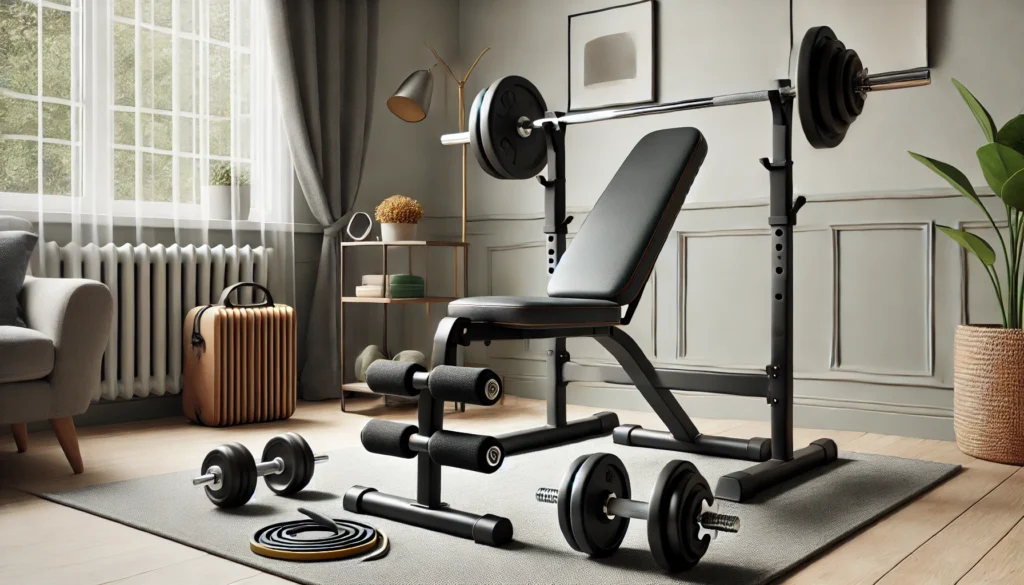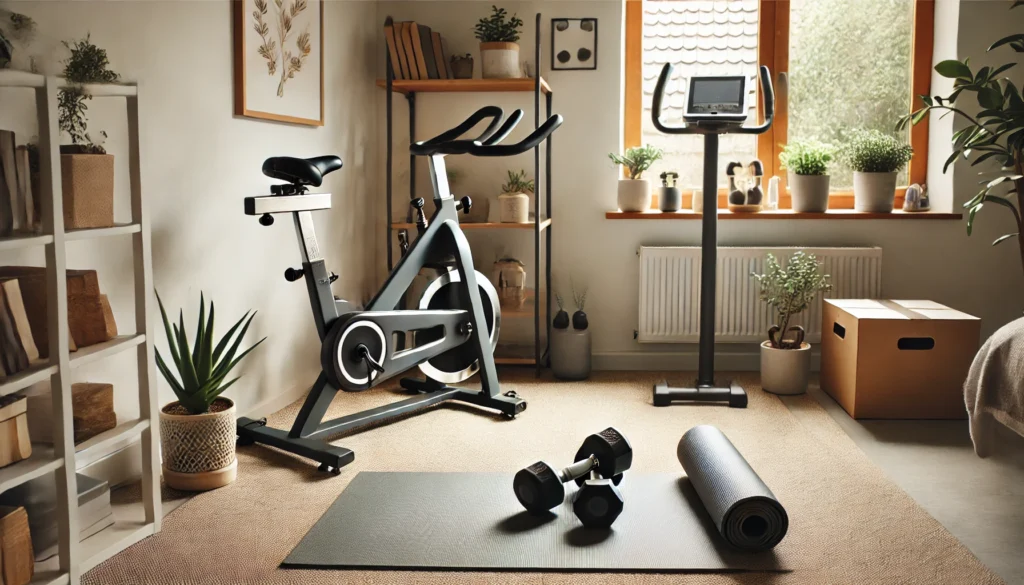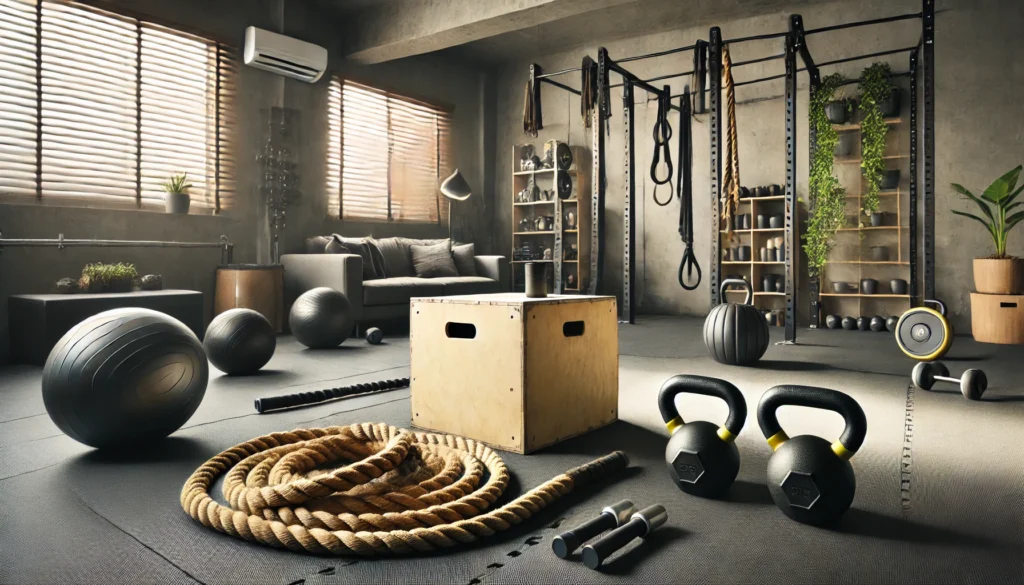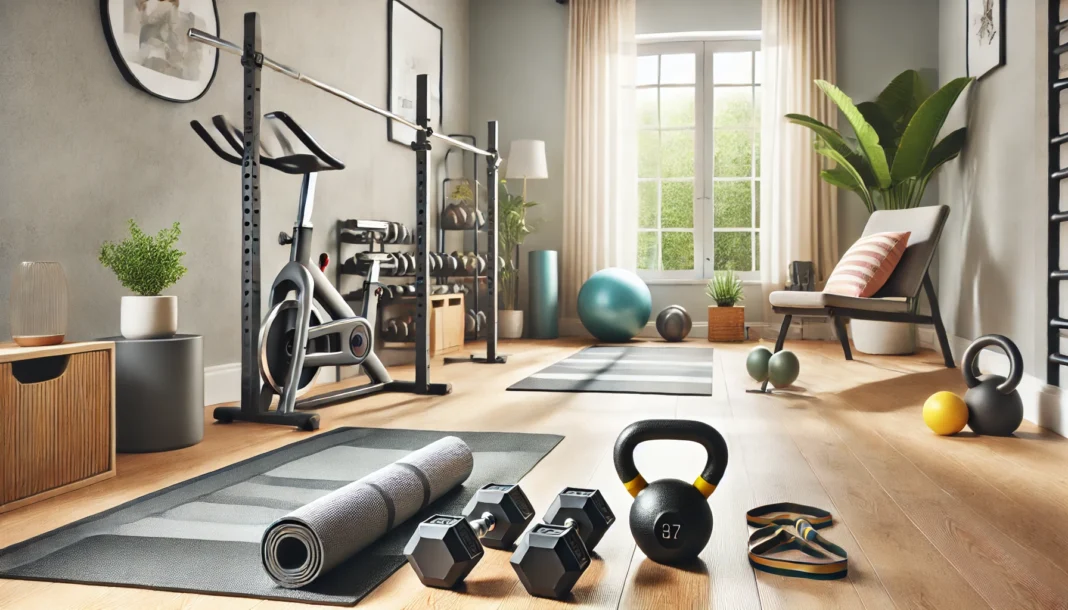Introduction: The Rise of Home Fitness and the Need for Great Equipment
The fitness industry has witnessed a dramatic shift toward home workouts, making it essential for fitness enthusiasts to invest in great fitness equipment. While traditional gym memberships once dominated the fitness landscape, home workouts now offer flexibility, convenience, and cost-effectiveness. The right equipment plays a crucial role in maximizing training efficiency, ensuring that individuals can target key muscle groups and progress in their fitness journey. Whether you are an advanced lifter or a beginner looking for the best home weight training equipment, selecting high-quality tools can significantly impact workout performance. This article explores the best home fitness equipment options, how they enhance strength and endurance, and why investing in quality training tools leads to long-term fitness success.
You may also like: The Ultimate Bodyweight Workout Routine for Full-Body Strength and Performance
The Benefits of Investing in High-Quality Home Fitness Equipment
Purchasing great fitness equipment is more than just a convenience—it is a crucial step toward achieving sustainable fitness goals. Unlike generic gym gear, well-designed home workout tools offer durability, adjustability, and multifunctionality, ensuring they meet the demands of progressive training. One of the biggest advantages of investing in the best home weight training equipment is the ability to customize workouts without time constraints, making training more efficient and adaptable. Additionally, home fitness equipment allows individuals to maintain consistency, reducing the risk of workout interruptions due to travel or gym closures. By prioritizing quality and versatility, fitness enthusiasts can build a comprehensive workout space tailored to their personal fitness needs.
Dumbbells: The Cornerstone of Home Strength Training
Among the best home weight training equipment, dumbbells remain an irreplaceable tool for building muscle and improving overall fitness. Adjustable dumbbells, in particular, offer versatility by allowing users to change weights easily, eliminating the need for multiple sets. Unlike machines, which limit movement patterns, dumbbells promote functional strength by engaging stabilizing muscles, leading to more effective muscle activation. Additionally, incorporating dumbbells into circuit training enhances cardiovascular endurance while simultaneously building strength. From compound exercises like squats and deadlifts to isolation movements such as bicep curls, dumbbells are an essential component of any home gym.
Resistance Bands: A Space-Saving Alternative to Traditional Weights
Resistance bands have emerged as a staple in home fitness due to their portability and effectiveness. These bands provide variable resistance, meaning the tension increases as they are stretched, leading to greater muscle engagement throughout the range of motion. Unlike free weights, which rely on gravity for resistance, bands allow for multidirectional force application, making them ideal for functional training. Great fitness equipment should be adaptable to all fitness levels, and resistance bands offer that flexibility by accommodating both beginners and experienced lifters. Furthermore, they are perfect for rehabilitation exercises, helping individuals recover from injuries while maintaining strength and mobility.

Kettlebells: Enhancing Power and Functional Fitness
Kettlebells are among the best home weight training equipment for those looking to develop power, coordination, and endurance. Their unique design allows for ballistic movements such as kettlebell swings, snatches, and cleans, which engage multiple muscle groups simultaneously. Unlike traditional weightlifting, kettlebell training emphasizes explosive movement patterns, making it highly effective for sports performance and cardiovascular conditioning. Additionally, kettlebells can be used for static strength exercises like Turkish get-ups, which enhance core stability and joint mobility. Investing in kettlebells ensures that home workouts remain dynamic and challenging, preventing training plateaus.
Adjustable Weight Benches: Versatility in Strength Training
A high-quality adjustable weight bench is one of the most valuable pieces of great fitness equipment for a home gym. It allows individuals to perform a variety of exercises, including bench presses, step-ups, and seated shoulder presses, expanding workout possibilities. The best home weight training equipment should offer adjustability, and an incline/decline bench provides multiple angles to target different muscle groups effectively. Additionally, pairing a bench with dumbbells or resistance bands enhances exercise variations, improving overall training outcomes. For those serious about strength training, investing in a durable and adjustable weight bench is essential for maximizing performance.
Barbells and Weight Plates: Essential for Progressive Overload
For individuals focusing on muscle hypertrophy and strength gains, barbells and weight plates are indispensable. Unlike machines that restrict movement, barbell training promotes natural biomechanics and engages stabilizing muscles, leading to more efficient strength development. The best home weight training equipment should allow for progressive overload, and barbells enable users to gradually increase resistance over time. Compound movements such as squats, deadlifts, and overhead presses provide full-body engagement, making barbell training a cornerstone of any serious strength program. Investing in a quality barbell and weight plate set ensures longevity and consistent performance in home workouts.
Suspension Trainers: Maximizing Bodyweight Resistance
Suspension trainers, such as TRX systems, utilize bodyweight resistance to develop strength, flexibility, and core stability. Unlike traditional weightlifting, suspension training requires constant core engagement to maintain control, leading to improved balance and coordination. Great fitness equipment should be adaptable to various fitness levels, and TRX systems allow users to modify intensity by adjusting body positioning. Exercises like suspended push-ups, pikes, and rows challenge multiple muscle groups while minimizing joint stress. Suspension trainers are particularly beneficial for those with limited space, as they can be anchored to a door frame or ceiling mount without requiring bulky equipment.
Smart Home Gym Systems: The Future of Connected Training
The rise of smart home gym systems has revolutionized home fitness, offering interactive and data-driven training experiences. Devices such as the Tonal or Mirror integrate artificial intelligence with strength training, providing real-time feedback on form and performance. Unlike traditional gym equipment, these systems incorporate personalized programming, making workouts more engaging and tailored to individual goals. The best home weight training equipment should enhance motivation and accountability, and smart fitness technology achieves this through virtual coaching and progress tracking. While these systems require a significant investment, they offer an unparalleled training experience for those seeking convenience and innovation in their workouts.

Frequently Asked Questions (FAQ) on Great Fitness Equipment for Home Workouts
1. What factors should I consider when selecting great fitness equipment for my home gym? Selecting great fitness equipment for your home gym depends on several key factors, including available space, fitness goals, and budget. It is essential to choose versatile equipment that allows for multiple exercises, such as adjustable dumbbells or resistance bands. Equipment durability and build quality should also be considered to ensure long-term use. Additionally, the best home weight training equipment should align with your current fitness level while offering room for progressive overload. Finally, assessing storage options and ease of assembly will help maintain an organized and functional home workout space.
2. What are the advantages of using the best home weight training equipment over bodyweight exercises? While bodyweight exercises are effective for building endurance and mobility, the best home weight training equipment offers more progressive resistance and muscle overload. Resistance training using adjustable dumbbells, barbells, or kettlebells enhances strength and hypertrophy faster than bodyweight movements alone. Equipment such as resistance bands and weighted vests can also be used to increase intensity, making workouts more challenging. Furthermore, structured equipment allows for more targeted muscle engagement, reducing reliance on momentum and improving exercise precision. Investing in great fitness equipment ensures continued progress and minimizes training plateaus.
3. How can smart fitness technology enhance home workouts? Smart fitness technology integrates data tracking, virtual coaching, and interactive programming into workouts, making them more engaging and personalized. Devices such as AI-driven strength training systems provide real-time feedback on exercise form, weight selection, and performance metrics. Some of the best home weight training equipment now includes app connectivity, allowing users to track their progress and adjust workouts accordingly. Smart resistance bands and digital weight systems provide precise resistance adjustments, ensuring optimal load management for strength gains. Incorporating technology into home workouts enhances motivation, accountability, and overall efficiency in achieving fitness goals.
4. What are some common mistakes to avoid when using weight training equipment at home? One of the most common mistakes is using improper form, which can lead to injury and inefficient muscle engagement. Another issue is neglecting warm-ups and mobility exercises before engaging with great fitness equipment, which increases the risk of strains and joint discomfort. Overloading weight without proper progression can also compromise technique and lead to setbacks. Additionally, failing to maintain and store equipment properly can result in wear and tear, reducing its lifespan. Finally, relying solely on one type of resistance, such as dumbbells, without incorporating variety can limit functional strength development.
5. How does kettlebell training compare to traditional weightlifting? Kettlebell training offers a unique combination of strength, power, and endurance, whereas traditional weightlifting primarily focuses on muscle hypertrophy and maximum strength. One of the main advantages of kettlebells as part of great fitness equipment is their emphasis on ballistic movements, such as swings and cleans, which improve cardiovascular fitness alongside strength. Unlike machines or barbells, kettlebells engage multiple muscle groups simultaneously, promoting functional fitness. Additionally, the offset center of mass in a kettlebell forces greater core activation during exercises. While traditional weightlifting is excellent for targeted strength gains, kettlebell training adds an element of dynamic movement beneficial for overall athleticism.
6. Can I build muscle effectively using only home weight training equipment? Yes, building muscle with the best home weight training equipment is entirely possible with the right approach. The key is to apply progressive overload by increasing weight, repetitions, or intensity over time. Adjustable dumbbells, barbells, and resistance bands allow for incremental weight increases, ensuring continuous muscle adaptation. Compound movements such as squats, deadlifts, and presses can be effectively performed using home fitness equipment, leading to significant strength gains. Consistency, proper nutrition, and strategic recovery are also essential for maximizing muscle growth in a home workout setting.
7. How can I create a full-body workout routine using home weight training equipment? A well-structured full-body workout should include exercises targeting all major muscle groups using the best home weight training equipment. Start with compound movements such as squats, lunges, and deadlifts to engage lower-body muscles. Follow up with upper-body exercises like bench presses, rows, and shoulder presses using adjustable dumbbells or barbells. Resistance bands can be incorporated for added tension in isolation movements, such as bicep curls or tricep extensions. Core-focused exercises, like kettlebell swings or suspension trainer planks, enhance overall stability and endurance. Rotating between these movements in a structured program ensures balanced strength development and prevents overuse injuries.
8. How do I maintain and store my home fitness equipment for longevity? Proper maintenance is crucial to extending the lifespan of your home weight training equipment. Regularly wiping down equipment with disinfectant prevents buildup of bacteria and sweat corrosion. Checking adjustable components on dumbbells or barbells ensures they remain secure and functional. Resistance bands should be inspected for signs of wear and stored in a cool, dry environment to prevent degradation. Investing in storage solutions, such as racks or wall mounts, helps keep equipment organized and minimizes clutter. By maintaining equipment properly, users can ensure optimal performance and safety over the long term.
9. What are some space-saving options for small home gyms? For those with limited space, selecting compact and multi-functional fitness equipment is key. Adjustable dumbbells replace the need for multiple weight sets, offering versatility while conserving space. Suspension trainers, such as TRX systems, provide a full-body workout and can be anchored to a door frame without occupying floor space. Foldable weight benches and stackable resistance bands allow for easy storage when not in use. The best home weight training equipment for small spaces should prioritize efficiency, ensuring a comprehensive workout without overcrowding the home gym. Maximizing wall storage with hooks or racks also helps optimize space usage.
10. What role does recovery equipment play in a home gym setup? Recovery equipment is just as essential as strength training tools in ensuring long-term progress and injury prevention. Foam rollers help release muscle tightness and improve blood circulation, reducing post-workout soreness. Massage guns provide targeted muscle relief, enhancing recovery after intense weight training sessions. Yoga mats and mobility sticks promote flexibility and joint health, ensuring a well-rounded approach to fitness. Investing in great fitness equipment should include recovery tools to balance strength training with proper muscle care. Prioritizing recovery ensures sustainability in fitness progress and reduces the risk of overtraining-related injuries.

Conclusion: Building a Complete Home Gym for Strength and Performance
Investing in great fitness equipment ensures that individuals can maintain a consistent and effective workout routine without relying on commercial gyms. The best home weight training equipment includes versatile tools such as dumbbells, resistance bands, kettlebells, and suspension trainers, all of which enhance strength, endurance, and functional fitness. Adjustable weight benches and barbell sets provide progressive overload, essential for muscle growth and long-term performance improvements. Additionally, the integration of smart gym systems represents the future of home fitness, offering personalized coaching and tracking capabilities. By carefully selecting high-quality fitness equipment, individuals can build a well-rounded training environment that supports long-term health and performance.
home fitness solutions, strength training essentials, resistance training, functional fitness, weightlifting equipment, home gym innovation, adjustable dumbbells, suspension training, kettlebell workouts, progressive overload, workout customization, personalized training, fitness tracking technology, injury prevention, muscle development, endurance training, smart home gym, full-body workouts, gym alternatives, fitness motivation.
Further Reading:
22 Best Home Gym Equipment Items to Shop This Year, Tested By Us
We’ve Tested Home Gym Equipment for Years—This Is the Best of the Best
12 Best Fitness Equipment When Home Workouts Are The Only Option
Important Note: The content provided by HealthXWire is for informational purposes only and should not be construed as medical advice, diagnosis, or treatment. While we strive for accuracy, the information presented on this site may not reflect the most current research or medical guidelines. Always seek the advice of your physician or other qualified health provider with any questions you may have regarding a medical condition. HealthXWire does not endorse, recommend, or guarantee the efficacy of any products, services, or treatments mentioned on this site. Users should not disregard professional medical advice or delay seeking it because of something they have read on HealthXWire. HealthXWire is not liable for any damages, loss, or injury arising from reliance on the information provided herein.



